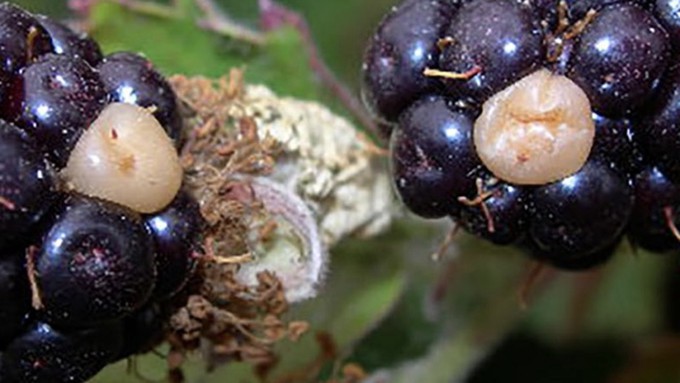
Discolored berries are another example of crops affected by intense summer heat

This close-up on two blackberries shows the white-to-tan drupelets that can develop in hot, dry weather. Courtesy UC Integrated Pest Management
Add another crop to our list of heat victims this summer: Blackberries.
Throughout the Sacramento region, blackberries are developing odd white or tan discoloration. The little drupelets – the juicy sacs that make up the berry – turn white or tan. It’s not just cosmetic; they generally don’t taste so good either. Often, the discolored drupelet withers to nothing but a dried seed.
I noticed these weird drupelets on my own Baby Cakes blackberries as well as the wild blackberries that grow near our home. Was it the heat?
Thanks to Farmer Fred Hoffman (and UC research), we know why: Excess UV radiation. (And yes, that’s related to the heat.)
Hoffman, host of “Garden Basics with Farmer Fred” podcast, solved this mystery in response to an Oroville listener who saw her berries go from pink to tan to yuck.
In his column, Hoffman recapped heat-related problems with other crops such as tomatoes.
“And now, you can add blackberries to the list of crops that develop problems when it gets too sunny, too hot, dry and windy, especially because of extended heatwaves. The problem is known as White Drupelet Disorder (WDD),” Hoffman wrote.
It’s not just a matter of adding shade; the berry plants need humidity.
According to the UC Integrated Pest Management Guidelines for Caneberries:
"White drupelet is a tan-to-white discoloration of one to many drupelets on the fruit. Most often, white drupelets will appear when there has been an abrupt increase in temperature accompanied by a drop in humidity; it is especially pronounced when there is wind. ...
“While white drupelets may seem to be directly caused by weather, they are actually caused by ultra-violet (UV) radiation,” note the UC experts. “Weather conditions modulate this by the effect they have on penetration of UV radiation into the fruit. Cool, humid air scatters and absorbs UV radiation, while hot dry air has the opposite effect and allows more direct UV rays to reach the fruit.
“The movement of humidity away from the canopy by wind only heightens the effect of hot dry air. Additionally, as humidity is moved away from the plant canopy, more UV rays penetrate the canopy and damage fruit that may not even have been exposed to the sun. Fruit inside of the canopy is not acclimatized to UV radiation and is subsequently more susceptible when it reaches them.”
How do you combat WDD? Make your own fog.
“Some growers of caneberries in the Willamette Valley of Oregon, where rapid changes from a normally mild climate to temperatures up to and above 100 degrees occur through the summer, use overhead irrigation to minimize fruit loss to white drupelet,” say the researchers. “This is not merely to mist the fruit; instead, large amounts of water are applied to thoroughly wet the canopy and maintain cool temperatures and high canopy humidity for as long as possible. Sprinkling is not done too late in the evening to allow fruit to dry before nightfall.”
Learn more here: https://ipm.ucanr.edu/agriculture/caneberries/white-drupelet/#gsc.tab=0
Hoffman also cited other university researchers. As other berry-growing regions get hotter and drier, WDD will only become a bigger problem.
Meanwhile, Hoffman offered tips for berry success in his “Beyond the Garden Basics” segment, plus reasons why taking time to smell the roses (and other aromatic plants) really is good for you in his Friday podcast, “Stressed? Your Garden Can Help.” (And who isn't this summer?)
Find Hoffman’s podcasts and more here: https://gardenbasics.net/.
Comments
0 comments have been posted.Sacramento Digs Gardening to your inbox.
Food in My Back Yard Series
May 6: Maintain soil moisture with mulch for garden success
April 29: What's (already) wrong with my tomato plants?
April 22: Should you stock up on fertilizer? (Yes!)
April 15: Grow culinary herbs in containers
April 8: When to plant summer vegetables
April 1: Don't be fooled by these garden myths
March 25: Fertilizer tips: How to 'feed' your vegetables for healthy growth
March 18: Time to give vegetable seedlings some more space
March 11: Ways to win the fight against weeds
March 4: Potatoes from the garden
Feb. 25: Plant a fruit tree now -- for later
Feb. 18: How to squeeze more food into less space
Feb. 11: When to plant? Consider staggering your transplants
Feb. 4: Starting in seed starting
Sites We Like
Garden Checklist for week of May 11
Make the most of the lower temperatures early in the week. We’ll be back in the 80s by Thursday.
* Plant, plant, plant! It’s prime planting season in the Sacramento area. Time to set out those tomato transplants along with peppers and eggplants. Pinch off any flowers on new transplants to make them concentrate on establishing roots instead of setting premature fruit.
* Direct-seed melons, cucumbers, summer squash, corn, radishes, pumpkins and annual herbs such as basil.
* Harvest cabbage, lettuce, peas and green onions.
* In the flower garden, direct-seed sunflowers, cosmos, salvia, zinnias, marigolds, celosia and asters. (You also can transplant seedlings for many of the same flowers.)
* Plant dahlia tubers.
* Transplant petunias, marigolds and perennial flowers such as astilbe, columbine, coneflowers, coreopsis, dahlias, rudbeckia and verbena.
* Keep an eye out for slugs, snails, earwigs and aphids that want to dine on tender new growth.
* Feed summer bloomers with a balanced fertilizer.
* For continued bloom, cut off spent flowers on roses as well as other flowering plants.
* Add mulch to the garden to maintain moisture. Mulch also cuts down on weeds. But don’t let it mound around the stems or trunks of trees or shrubs. Leave about a 6-inch-to-1-foot circle to avoid crown rot or other problems.
* Remember to weed! Pull those nasties before they set seed.
* Water early in the day and keep seedlings evenly moist.